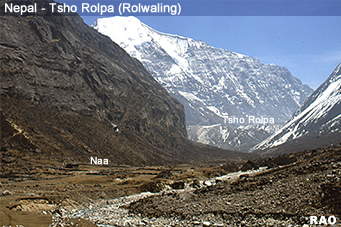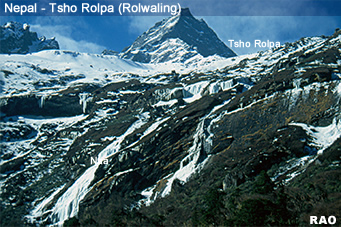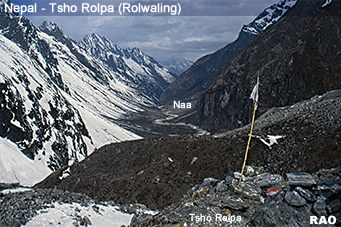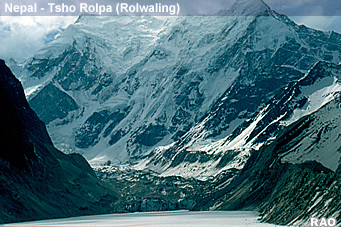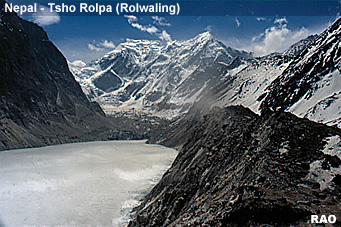| Nepal's
Glaciers - Climate Change |
 |
Nepal Himalayas Glaciers |
|
 |
Nepal Information |
|
|
 |
| Glacial Lakes Outburst Flood (GLOF) |
| Tsho Rolpa - Early Warnung System (EWS) |
 |
 |
|
Even as Nepal tries to grapple with the aftermath of a powerful earthquake and its aftershocks, UNDP is already working with the Government of Nepal and private sector to mitigate the risk of another looming danger: The Glacial Lake Outburst Floods (GLOF) which threatens millions downstream.
A team including experts from the government's Department of Hydrology and Metrology (DHM), and UNDP's consulting firm, Real Time Solutions visited Tsho Rolpa lake situated in Dolakha district on May 16 and installed an early warning system that provides an advance warning for the downstream communities in the event of a moraine breach and outburst flood.
The Tsho Rolpa situated at an altitude of 4,580 meter, is one of the biggest glacial lakes in Nepal and even before the earthquake it was considered be at high risk.
|
|
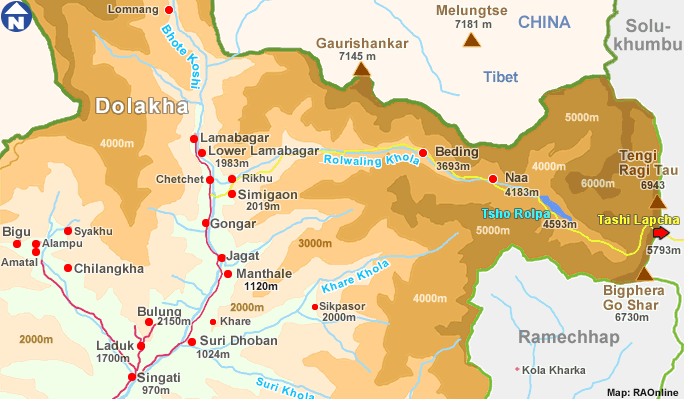 |
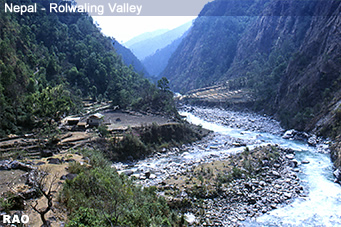 |
The expert team flew on a helicopter supported by Himal Power Limited (HPL) with necessary equipment and installed the automated early warning system that will measure changes in lake water level, providing significant lead time to downstream communities.
UNDP has already reached an understanding with the private sector such as hydro power companies working in Tamakoshi and Rolwaling Valley, to share the cost of mitigating GLOF risks. Nepal Telecom has already started to expand their mobile reception towers so as to support for last mile connectivity. |
|
EWS Guideline for Dolakha has been already prepared and endorsed by District Disaster Relief Committee which ensures the cost sharing for sustainable functioning of the EW system. At least 3 large hydro power plants and a number of micro-hydros will be washed away in the event of a glacial flood.
An early warning system set up earlier in 1998 by DHM with support of other development partners stopped functioning after four years of its installation during the time when the country was undergoing violent conflict.
Since 2013, UNDP was working with the Government to put into place the system that is owned and operated by the local communities themselves and is interlinked with district and national level Emergency Operation Centres.
"The increased seismic activity after a major aftershock of 26 April 2015 around Sindhupalchok and Dolakha heightened concerns about GLOF and increased urgency of expediting early warning system," said Vijaya Singh, Assistant Country Director at UNDP Nepal. In a statement, Department of Hydrology and Metrology said it has been continuously observing the glacial lake and that no damage has been recorded so far because of recent tremor.
The early warning station uses two sensors, one radar level sensor and another water content sensor. "The radar level sensor will start reading the water level if the river discharge increases," said Saroj Joshi, an expert form UNDP's consulting firm, Real Time Solutions. "An advance warning triggered by these sensors is expected help save life and decrease the damage in the downstream in case of any outburst flood," said Deepak KC, a senior program officer for integrated climate risk management at UNDP Nepal.
Nepal has experienced 24 GLOF events in the recent past, several of which have caused considerable damage and loss of life, for example, the Bhote Koshi Sun Koshi GLOFs of 1964 and 1981 and the Dig Tsho GLOF of 1985. The 1981 event damaged the only road link to China and disrupted transportation for several months, while the Dig Tsho GLOF destroyed the nearly completed Namche Small Hydroelectric Project, in addition to causing other damage farther downstream.
 |
| Source:
Text UNDP, May 2015 |
 |
|
Nepal |
top
|
more information
|
 |
| Snow, Ice, Glaciers, Glacial Lakes and Floods - Reports |
 |
| Himalayas |
 |
Snow, Ice, Glacier, Glacial Lakes and Floods Reports |
 |
| Links |
 |
 |
 |
External
link |
 |
| Tsho
Rolpa, Rolwaling Valley |
|





